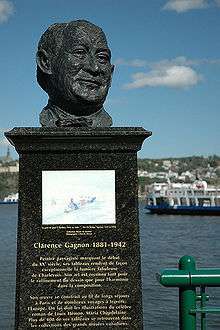Clarence Gagnon
| Clarence A. Gagnon | |
|---|---|
 Bust of Clarence Gagnon in Quebec City. | |
| Born |
Clarence Alphonse Gagnon November 8, 1881 Near Montreal, Quebec |
| Died |
January 5, 1942 (aged 60) Montreal |
| Nationality | Canadian |
| Education | Art Association of Montreal, with William Brymner; Académie Julian, with Jean-Paul Laurens |
| Known for | painting, engraving, illustrating |
| Movement | Modernity |
| Spouse(s) | Lucile Rodier |
| Awards | Trevor Prize, LL.D. (honorary, University of Montreal) |
Clarence Alphonse Gagnon, R.C.A., (8 November 1881 – 5 January 1942) was a Canadian painter, draughtsman, engraver and illustrator, from the province of Quebec. He is well known for his landscape paintings of the Laurentians and the Charlevoix region of eastern Quebec.
Early years and training
Clarence Alphonse Gagnon was born in Montreal on November 8, 1881. He was the son of Alphonse E. Gagnon, a milling manager, and a cultured English mother, who was interested in literature. Part of his childhood was spent in Sainte Rose, a village north on Montreal. Early in life, his mother had encouraged him to learn drawing and painting, but his father wanted him to become a businessman.
He studied with William Bremner at the Art Association of Montreal in 1897.[1] Desiring to improve his knowledge about art, he went to the Académie Julian in Paris, and studied under Jean-Paul Laurens from 1904 to 1905. Before returning to Canada in 1909, Gagnon spent time painting in France and Italy.[2][3][4][5]
Career
He then lived in Baie-Saint-Paul, where he produced many paintings depicting nature and the Canadian people. He invented a new kind of winter landscape that consisted of mountains, valleys, sharp contrasts, vivid colours, and sinuous lines. He became a member of the Royal Canadian Academy of Arts in 1922.[6]
Gagnon took trips to Venice, Rouen, Saint-Malo and the Laurentians in Quebec to paint landscapes. He illustrated the pages of the novel Maria Chapdelaine by Louis Hémon. As well, he was the illustrator for Louis-Frédéric Rouquette in 1929 in Le Grand silence blanc. He lived in France from 1924 to 1936.
In 1919 Gagnon married Lucile Rodier, also a pupil of William Bremner. Gagnon advanced modernist painting within Canada. One of his disciples was the painter René Richard. Gagnon's works were exhibited at Gallery L'Art français.[7] His paintings and etchings are included in collections at The National Gallery (Ottawa), The Art Gallery of Toronto, Montreal Art Association Gallery, Vancouver Art Gallery, Victoria and Albert Museum (London), Walker Gallery (Liverpool), Manchester Art Gallery (England), and Petit Palais (Paris). His works are also held in collections in Halifax, Saint John (N.B.), The Hague, Dresden, Florence and Venice.[8]
Gagnon died on January 5, 1942 at the Royal Victoria Hospital in Montreal. He was survived by his wife and three brothers, Wilford, Ernest and Frederick. He is buried at the Notre-Dame-des-Neiges Cemetery in Montreal.[9] A bust has been erected in his memory by the Galerie Clarence Gagnon in Quebec City.
References
- ↑ "Clarence Gagnon". www.gallery.ca. Retrieved October 3, 2013.
- ↑ Reid, Dennis (1973). A Concise History of Canadian Painting. Toronto: Oxford University Press. p. 127. ISBN 0195402065.
- ↑ National Gallery of Canada
- ↑ Benezit Dictionary of Artists
- ↑ Grove Art Online
- ↑ "Members since 1880". Royal Canadian Academy of Arts. Archived from the original on 26 May 2011. Retrieved 11 September 2013.
- ↑ "L'Art Français in Montreal", Gallery Profile, in Le Collectionneur, Vol.1, n°2, 1978, "L'Art Français also sold the paintings of more "classical" painters such as (...) Clarence Gagnon"
- ↑ "Clarence Gagnon], Canadian Artists Series, Albert H. Robson, The Ryerson Press," (PDF). Retrieved January 24, 2016.
- ↑ "Clarence Gagnon, Find A Grave". Retrieved January 24, 2016.
External links
- Works by or about Clarence Gagnon at Internet Archive
- Clarence Gagnon biography page at National Gallery of Canada
- Clarence Gagnon page on Find A Grave Retrieved January 24, 2016
- Clarence Gagnon, Canadian Artists Series, Albert H. Robson, The Ryerson Press, Retrieved January 24, 2016